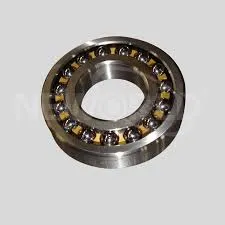
Nov . 19, 2024 08:14 Back to list
Understanding Tapered Roller Bearing Applications and Advantages in Industrial Machinery
Tapered Roller Bearings An Overview
Tapered roller bearings are a crucial component in a variety of mechanical applications, renowned for their ability to support both axial and radial loads. This unique design makes them especially versatile, serving industries ranging from automotive to aerospace and heavy machinery. In this article, we will explore the essential characteristics, advantages, applications, and maintenance practices associated with tapered roller bearings.
Design and Characteristics
A tapered roller bearing consists of an inner ring, an outer ring, tapered rollers, and a cage that holds the rollers in place. The rollers have a conical shape, which enables them to create a line contact with the raceways of the inner and outer rings. This design allows for efficient load distribution over a larger surface area, significantly reducing point contact stress that is common in other types of bearings.
One of the standout features of tapered roller bearings is their ability to handle combined loads. They can accommodate both axial and radial forces, making them suitable for situations where directional forces need to be managed simultaneously. This is especially vital in applications like wheel hubs in vehicles, where forces from acceleration, braking, and cornering must all be considered.
Advantages
The advantages of tapered roller bearings are manifold. Firstly, they offer higher load capacities compared to other bearing types, making them ideal for heavy-duty applications. Their ability to handle both axial and radial loads improves system reliability and performance.
Additionally, tapered roller bearings typically have lower friction compared to plain bearings or some other rolling element bearings. This leads to improved energy efficiency, which is a significant concern in industries focused on sustainability and cost reduction. The reduced friction also contributes to lower operational temperatures, thus prolonging the bearing's service life.
Moreover, they are designed for easy adjustment and assembly. The tapered design allows for precise adjustments in bearing preload, which can be crucial for maintaining optimal performance in dynamic applications. Easy installation and adjustment mean reduced downtime and lower maintenance costs.
tapered roller bearing deutsch

Applications
Tapered roller bearings find applications across a wide range of sectors. In the automotive industry, they are commonly used in wheel bearings, driveshafts, and axles. Their ability to withstand high loads and impacts makes them a preferred choice for heavy trucks and commercial vehicles.
In the construction and mining industries, tapered roller bearings are essential in various machinery, including excavators, bulldozers, and cranes. These applications demand high reliability under extreme conditions, and tapered roller bearings deliver the requisite performance.
Furthermore, they are utilized in aerospace applications, industrial machinery, and even in home appliances where compact, efficient bearings are necessary. The diverse applicability of tapered roller bearings underscores their significance in modern engineering and manufacturing.
Maintenance and Care
To ensure longevity and reliable performance, proper maintenance of tapered roller bearings is essential. Regular inspections should be conducted to check for signs of wear or damage. Lubrication is also critical; using the right type and amount of lubricant can reduce friction and wear, thus extending the service life of the bearings.
In addition, it’s important to monitor operating temperatures and vibrations, as any significant changes could indicate potential problems. Bearing misalignment and improper installation can lead to premature failure, so adherence to manufacturer guidelines is crucial during assembly and maintenance.
Conclusion
In conclusion, tapered roller bearings are fundamental components in a myriad of mechanical systems, characterized by their unique design that allows for efficient handling of both axial and radial loads. With extensive applications across various industries, their advantages in terms of load capacity, friction reduction, and ease of maintenance make them an invaluable choice for engineers and manufacturers alike. As industries continue to evolve, the role of tapered roller bearings will remain integral, facilitating advancements in technology and machinery efficiency. Their ongoing innovation and development underscore their importance in the future of mechanical engineering.
Latest news
-
Grooved Ball Bearing Design and Functionality
NewsJun.04,2025
-
Concrete Mixer Bearing Load Capacity Testing
NewsJun.04,2025
-
6004 Bearing Dimensions in Robotic Joint Designs
NewsJun.04,2025
-
Advantages of Single-Row Deep Groove Ball Bearings
NewsJun.04,2025
-
Applications of Deep Groove Ball Bearings in Automotive Systems
NewsJun.04,2025
-
Innovations in Bearing Pressing Machine Design
NewsJun.04,2025
